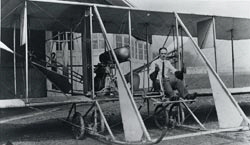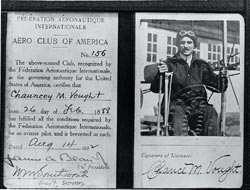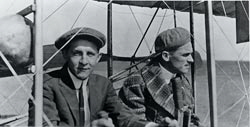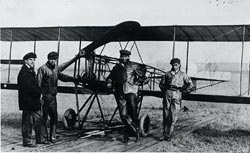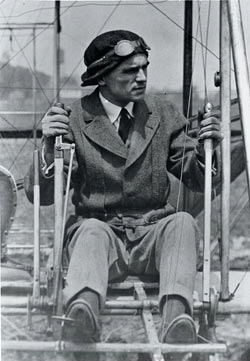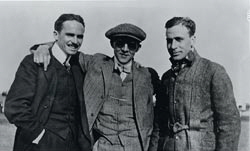|
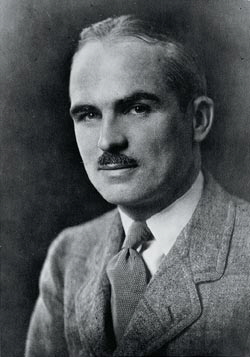 The story of Vought Aircraft Company begins with Chance Vought, the man. Chauncey (Chance) Milton Vought was born to George Washington and Annie E. Vought, on February 26, 1890 on Long Island, New York. His parents had a successful business designing and building quality sailing boats but little is known of Chauncey's early childhood except that he had displayed an early talent for mechanical things. The story of Vought Aircraft Company begins with Chance Vought, the man. Chauncey (Chance) Milton Vought was born to George Washington and Annie E. Vought, on February 26, 1890 on Long Island, New York. His parents had a successful business designing and building quality sailing boats but little is known of Chauncey's early childhood except that he had displayed an early talent for mechanical things.
Chance Milton Vought was only thirteen years old when Orville Wright, on the morning of December 17, 1903, became the first man to officially pilot and fly a heavier-than-air machine. Young Chance's reaction to this historical event has not been recorded but we know that it must have greatly influenced his engineering studies and thinking. His elementary school education was in the New York Public School System and, upon graduation he entered the Pratt Institute of Brooklyn. 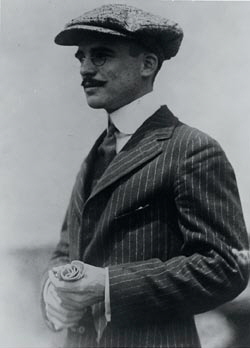 He transferred later to New York University, where he specialized in the study of the internal combustion engine, and then transferred to the University of Pennsylvania in search of better engineering courses. Several sources suggest that he was making a worthy study of aeronautical engines, an interesting note because, for the most part, the American public in 1910 was not interested in aviation activities. He transferred later to New York University, where he specialized in the study of the internal combustion engine, and then transferred to the University of Pennsylvania in search of better engineering courses. Several sources suggest that he was making a worthy study of aeronautical engines, an interesting note because, for the most part, the American public in 1910 was not interested in aviation activities.
A superb student, he was usually ahead of his class in the theory and principles of engineering. Chance left school in 1910 to work for Harold McCormick an early aviation backer who was president of McCormick Reapers. The first aircraft that Chance Vought was associated with was the McCormick-Romme "Umbrella" plane which flew on March 11, 1910. He learned to fly from Max Lillie in 1912 using a Wright biplane and received FAI pilots certificate number 156. It was on this certificate that he signed his name
Chance M. Vought rather than the printed name Chauncey M. Vought. This was the first official indication that Chauncey preferred the name "Chance". He became an aeronautical engineer and instructor pilot for the Max Lillie School of Aviation in 1913 and was involved in the design of the Lillie-Vought tractor biplane. While at Lillie he also edited the pioneer American aviation weekly, "Aero and Hydro".
Having developed some sound and unique ideas on airplane design, Vought went to work at the Mayo Radiator Works. His first aircraft design, the Mayo-Vought Simplex was built in 1914, and first flew in May of 1915. It was used by the British as a WW I pilot trainer. Vought worked for Curtiss briefly in 1915 as a consulting engineer for flying boats. In the fall of 1916 he became chief engineer at the Wright Company of Dayton, Ohio. In 1916 the Wright Company and The Glenn L. Martin Company merged to form The Wright-Martin Aircraft Corporation. During his brief tenure there, the Wright-Martin Model V was produced; the first flight of the Model V was in September 1916. Vought was sent to Europe to survey the tactical employment of airplanes and the impact of the war on their design.
When the United States entered World War I in April of 1917, the country was basically unprepared for war, especially so in military aviation. The American airplane industry was ignorant of combat airplane technology, since any advancements in the state-of-the-art were jealously guarded by the various combatants. Therefore, the decision was made for America to concentrate on building training airplanes and purchasing combat airplanes from the Allies. The need for trainers became pressing, and contracts were awarded to many inexperienced firms. With his past experience on several designs and his sporting nature, Chance Vought joined with Birdseye Lewis to form a company and take advantage of the trainer aircraft opportunities. The company was formed as the Lewis and Vought Corporation on June 18, 1917. The company, under various names, has been in continuous operation since then and is the second oldest airframe manufacturer in the United States. (The Boeing Company was the first.)
Chance Milton Vought died unexpectedly on July 25, 1930 from septicemia (blood poisoning) at the age of 42.
Chance Vought was inducted into the Aviation Hall of Fame in 1989 and even though he did not live to see many of them, more than 15,000 aircraft and missiles bearing the Vought name have been built since 1917.
A Shorter Biography of Chance Milton Vought
Chance M. Vought written by Eugene E. Wilson
|

 The story of Vought Aircraft Company begins with Chance Vought, the man. Chauncey (Chance) Milton Vought was born to George Washington and Annie E. Vought, on February 26, 1890 on Long Island, New York. His parents had a successful business designing and building quality sailing boats but little is known of Chauncey's early childhood except that he had displayed an early talent for mechanical things.
The story of Vought Aircraft Company begins with Chance Vought, the man. Chauncey (Chance) Milton Vought was born to George Washington and Annie E. Vought, on February 26, 1890 on Long Island, New York. His parents had a successful business designing and building quality sailing boats but little is known of Chauncey's early childhood except that he had displayed an early talent for mechanical things.
 He transferred later to New York University, where he specialized in the study of the internal combustion engine, and then transferred to the University of Pennsylvania in search of better engineering courses. Several sources suggest that he was making a worthy study of aeronautical engines, an interesting note because, for the most part, the American public in 1910 was not interested in aviation activities.
He transferred later to New York University, where he specialized in the study of the internal combustion engine, and then transferred to the University of Pennsylvania in search of better engineering courses. Several sources suggest that he was making a worthy study of aeronautical engines, an interesting note because, for the most part, the American public in 1910 was not interested in aviation activities.
